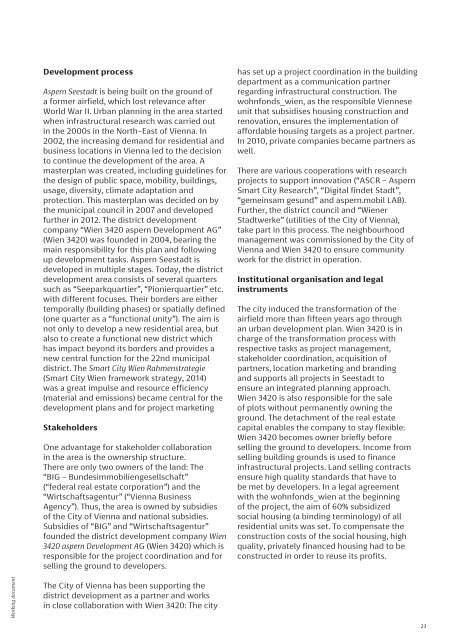Cities4PEDs Atlas_November 2021.pdf
Atlas - From 7 case interviews to recurring strategies and PED relevant aspects
Atlas - From 7 case interviews to recurring strategies and PED relevant aspects
- No tags were found...
You also want an ePaper? Increase the reach of your titles
YUMPU automatically turns print PDFs into web optimized ePapers that Google loves.
Development process<br />
Aspern Seestadt is being built on the ground of<br />
a former airfield, which lost relevance after<br />
World War II. Urban planning in the area started<br />
when infrastructural research was carried out<br />
in the 2000s in the North-East of Vienna. In<br />
2002, the increasing demand for residential and<br />
business locations in Vienna led to the decision<br />
to continue the development of the area. A<br />
masterplan was created, including guidelines for<br />
the design of public space, mobility, buildings,<br />
usage, diversity, climate adaptation and<br />
protection. This masterplan was decided on by<br />
the municipal council in 2007 and developed<br />
further in 2012. The district development<br />
company “Wien 3420 aspern Development AG”<br />
(Wien 3420) was founded in 2004, bearing the<br />
main responsibility for this plan and following<br />
up development tasks. Aspern Seestadt is<br />
developed in multiple stages. Today, the district<br />
development area consists of several quarters<br />
such as “Seeparkquartier”, “Pionierquartier” etc.<br />
with different focuses. Their borders are either<br />
temporally (building phases) or spatially defined<br />
(one quarter as a “functional unity”). The aim is<br />
not only to develop a new residential area, but<br />
also to create a functional new district which<br />
has impact beyond its borders and provides a<br />
new central function for the 22nd municipal<br />
district. The Smart City Wien Rahmenstrategie<br />
(Smart City Wien framework strategy, 2014)<br />
was a great impulse and resource efficiency<br />
(material and emissions) became central for the<br />
development plans and for project marketing<br />
Stakeholders<br />
One advantage for stakeholder collaboration<br />
in the area is the ownership structure.<br />
There are only two owners of the land: The<br />
“BIG – Bundesimmobiliengesellschaft”<br />
(“federal real estate corporation”) and the<br />
“Wirtschaftsagentur” (“Vienna Business<br />
Agency”). Thus, the area is owned by subsidies<br />
of the City of Vienna and national subsidies.<br />
Subsidies of “BIG” and “Wirtschaftsagentur”<br />
founded the district development company Wien<br />
3420 aspern Development AG (Wien 3420) which is<br />
responsible for the project coordination and for<br />
selling the ground to developers.<br />
has set up a project coordination in the building<br />
department as a communication partner<br />
regarding infrastructural construction. The<br />
wohnfonds_wien, as the responsible Viennese<br />
unit that subsidises housing construction and<br />
renovation, ensures the implementation of<br />
affordable housing targets as a project partner.<br />
In 2010, private companies became partners as<br />
well.<br />
There are various cooperations with research<br />
projects to support innovation (“ASCR – Aspern<br />
Smart City Research”, “Digital findet Stadt”,<br />
“gemeinsam gesund” and aspern.mobil LAB).<br />
Further, the district council and “Wiener<br />
Stadtwerke” (utilities of the City of Vienna),<br />
take part in this process. The neighbourhood<br />
management was commissioned by the City of<br />
Vienna and Wien 3420 to ensure community<br />
work for the district in operation.<br />
Institutional organisation and legal<br />
instruments<br />
The city induced the transformation of the<br />
airfield more than fifteen years ago through<br />
an urban development plan. Wien 3420 is in<br />
charge of the transformation process with<br />
respective tasks as project management,<br />
stakeholder coordination, acquisition of<br />
partners, location marketing and branding<br />
and supports all projects in Seestadt to<br />
ensure an integrated planning approach.<br />
Wien 3420 is also responsible for the sale<br />
of plots without permanently owning the<br />
ground. The detachment of the real estate<br />
capital enables the company to stay flexible:<br />
Wien 3420 becomes owner briefly before<br />
selling the ground to developers. Income from<br />
selling building grounds is used to finance<br />
infrastructural projects. Land selling contracts<br />
ensure high quality standards that have to<br />
be met by developers. In a legal agreement<br />
with the wohnfonds_wien at the beginning<br />
of the project, the aim of 60% subsidized<br />
social housing (a binding terminology) of all<br />
residential units was set. To compensate the<br />
construction costs of the social housing, high<br />
quality, privately financed housing had to be<br />
constructed in order to reuse its profits.<br />
Working document<br />
The City of Vienna has been supporting the<br />
district development as a partner and works<br />
in close collaboration with Wien 3420: The city<br />
23


















